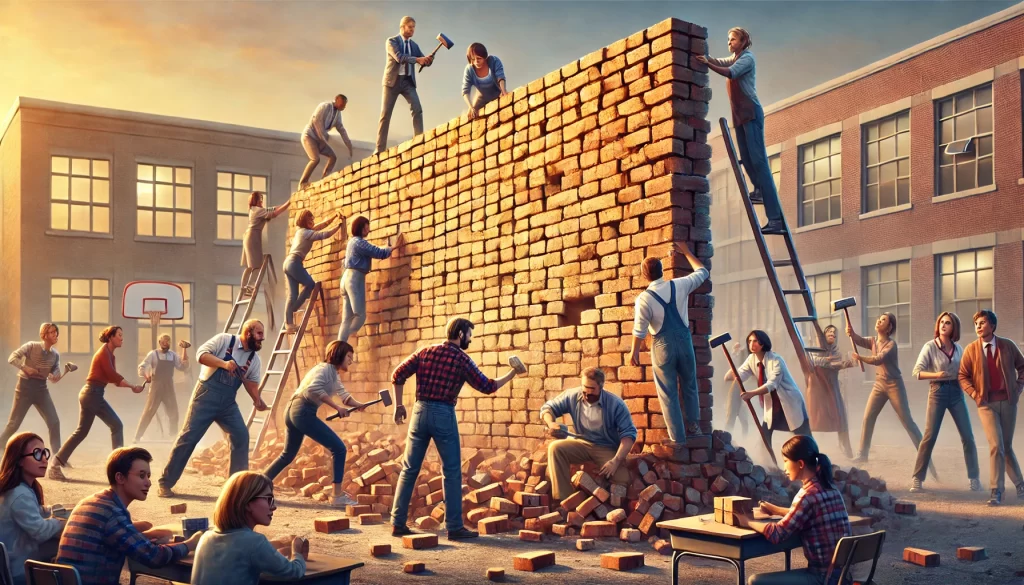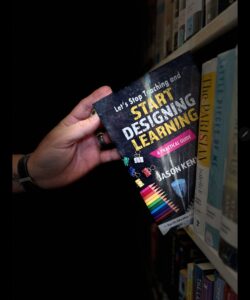First, you probably are humming the song by Pink Floyd already, so let’s run with that analogy. Imagine you’re walking down a road, headed toward an important destination. Along the way, you encounter a massive brick wall blocking your path. You sigh, turn around, and walk away. It seems like an immovable obstacle, an undeniable fact of your reality. But what if you built that wall yourself? What if, brick by brick, you stacked your own doubts, fears, and assumptions until they formed a barrier that kept you from moving forward?
Excuses are those bricks. And as educators, we are some of the most skilled masons when it comes to building them.
Every day, teachers and school leaders justify why things can’t change, why learners won’t succeed, and why our best efforts will never be enough. But here’s the truth: excuses only exist because we create them. If we built the wall, we can also tear it down.
The First Brick – A Lack of Belief in Ourselves
One of the primary reasons we make excuses is because we don’t fully believe in our own capabilities. Imposter syndrome is rampant in education. Teachers doubt their effectiveness, leaders question their decisions, and the sheer weight of responsibility can feel overwhelming. The belief that “I’m not good enough” seeps into our mindset and, over time, becomes an excuse that keeps us from pushing forward.
This lack of self-belief often stems from systemic issues in teacher preparation. I point out in my book that many educators enter the profession with little to no formal instruction on how learning actually happens. This gap in knowledge fosters uncertainty, leading to a teaching approach rooted in self-preservation rather than confident innovation.
How to Break that Brick:
We combat this doubt by shifting our focus from “Do I know enough?” to “Am I willing to learn?” The best educators are not those who claim expertise, but those who relentlessly seek it. Hattie’s research on teacher collective efficacy (effect size of 1.39) shows that when educators believe in their ability to impact learning, learner outcomes improve significantly. When we trust in our own ability to grow and adapt, we stop making excuses and start designing solutions.
Instead of saying, “I can’t reach these learners,” we should be asking, “What haven’t I tried yet?” The moment we decide to believe in our own capacity, the first brick of the wall crumbles.
The Second Brick – A Lack of Belief in Our Learners
It’s easy to blame learners for their lack of engagement, motivation, or achievement. We tell ourselves they don’t care, they’re lazy, they come from homes that don’t value education. And with every justification, we add another brick to the wall separating us from their potential.
Research tells a different story. Hattie’s expectations for learners has an effect size of 0.43—meaning that when teachers have high expectations for their learners, academic performance improves significantly. Unfortunately, too often, we operate with a deficit mindset, assuming learners are incapable rather than asking how we can meet them where they are.
How to Break that Brick:
Instead of assuming a learner won’t learn, assume you just haven’t found the right way yet. This is the essence of a learner-centered classroom. When we stop viewing learners as problems to manage and start seeing them as potential waiting to be unleashed, everything shifts.
Sulla’s Learner-Active, Technology-Infused Classroom model challenges us to stop teaching passively and start designing environments that engage learners as problem-solvers, decision-makers, and critical thinkers. Our job is not to fill their heads with information, but to create opportunities where they can prove to themselves what they are capable of.
If we stop believing that learner success is out of our hands, another brick falls from the wall.
The Third Brick – Believing Mistakes Are Failures
Education has long had an obsession with perfection. Mistakes are graded, penalized, and treated as evidence of incompetence rather than opportunities for growth. Because of this, teachers avoid risk, fearing they’ll be judged if a new strategy doesn’t work. Learners, too, hesitate to step outside their comfort zones, terrified of failing in front of their peers.
This mindset is directly opposed to what we know about learning. Dweck’s research on growth mindset demonstrates that when learners (and teachers) see mistakes as a natural part of the learning process, performance improves. In fact, the highest levels of expertise in any field are reached through cycles of trial, error, and adjustment.
How to Break that Brick:
We must redefine failure. A mistake is not proof of incompetence—it is data. When something doesn’t work, it is simply feedback that tells us what to adjust. This applies to learners struggling with a math problem, teachers experimenting with new instructional strategies, and leaders making tough decisions.
If education is truly a professional practice, then mistakes are discoveries. The best teachers are not those who avoid failure but those who reflect on it, learn from it, and adapt.
When we stop fearing mistakes, the final brick of the wall falls.
The Clear Way Forward
The wall of excuses is gone. The path forward is clear.
Excuses are comfortable. They allow us to shift responsibility onto external factors rather than acknowledging our own power to change. But real growth—real transformation—begins when we take ownership of our beliefs, our actions, and our ability to make a difference.
Tear down the walls. Trust in yourself. Believe in your learners. Embrace mistakes as part of the process.
The road ahead is yours to walk.


